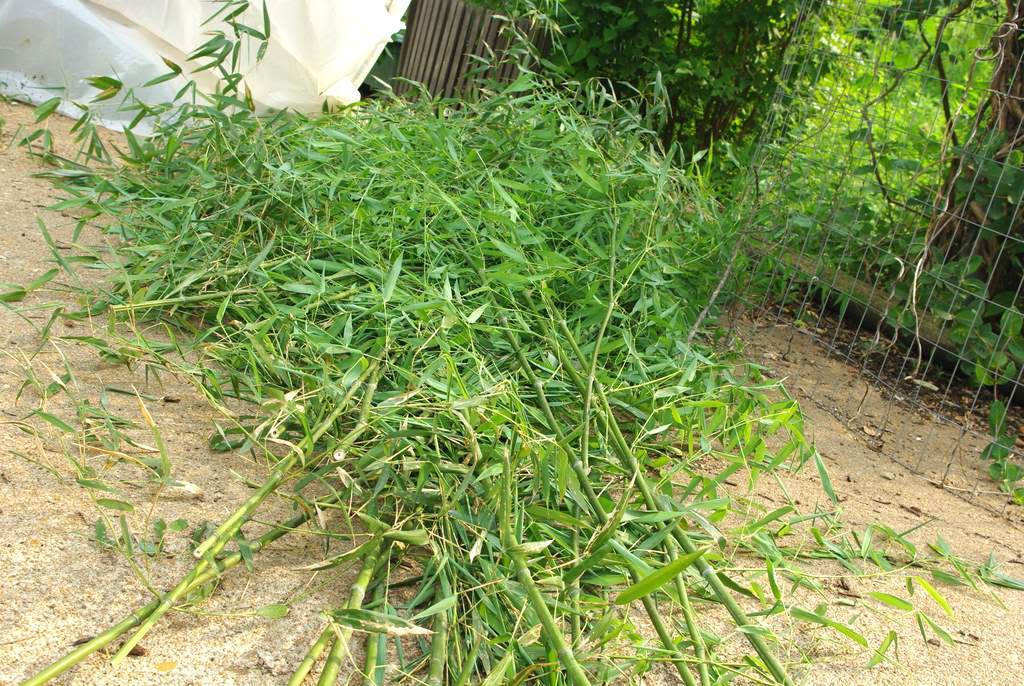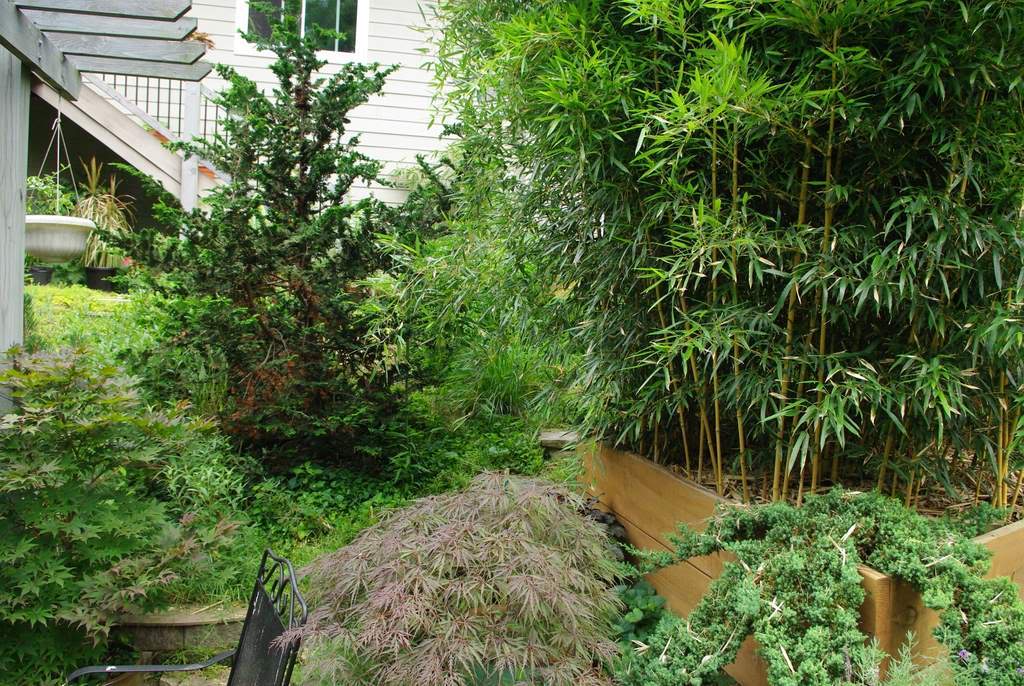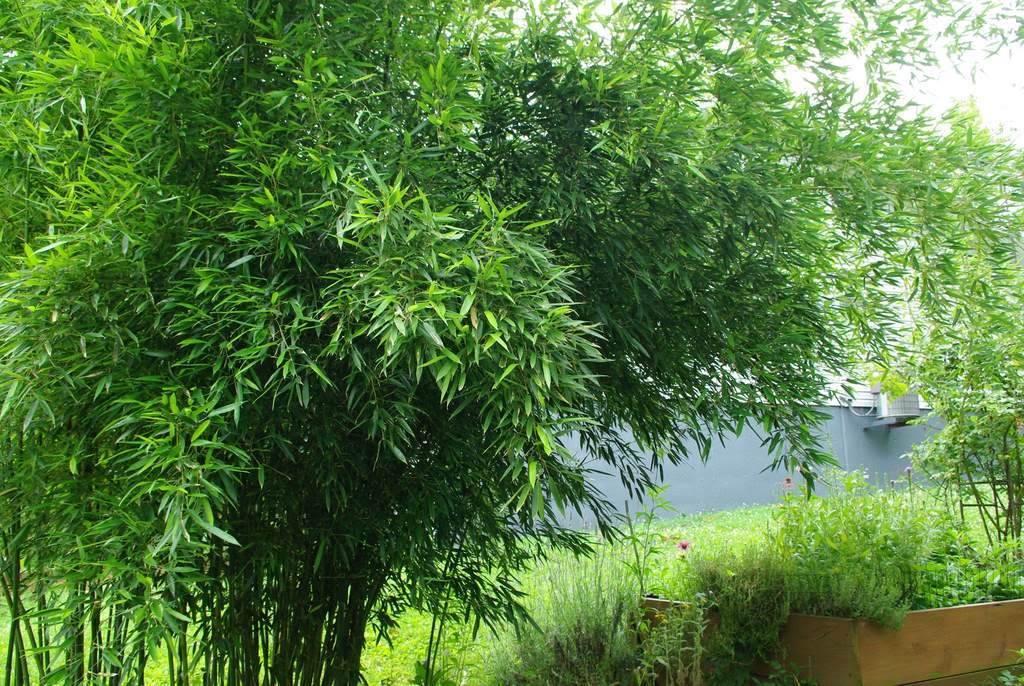You know how at some point in the season some plants just go crazy, get out of hand? Whether from a growth spurt, from lack of attention on your part, or some interference by Mother Nature plants get too big, start leaning, fall off their supporting structures, hang a branch where it isn't wanted -- in short, they just need some human intervention to get back in line. Maybe some sharp-edged tools need to touch them. Maybe they just need to be introduced to some twine or strong cord. I have plants like that. I call them "bamboo".
If you grow bamboo and have limited growing space like I do, it's a fact of life that you'll need to deal with wayward shoots, spreading rhizomes, and floppy culms (canes) at least once a year with each plant. Today I've got a few of those bamboo projects related to floppy or leaning culms to write about.
The first project is quite straightforward. This Phyllostachys bissetii bamboo next to my driveway wants to lean over the drive due to trees behind and above it:
It's reaching for more sunlight, and on this end of the grove it's too much. It's blocking the little path I have through there, it's shading a large Miscanthus (which gets floppy if it doesn't get enough sunlight), and is blocking my view of some other plants. You won't know what I'm talking about until you see the "after" image below.
The solution in this case?
Loppers! I removed around a dozen culms which would have been unthinkable just a year ago, but since this grove must have produced at least 150 new culms this year it was nothing.
When I first started getting into bamboo, I would cringe at the cavalier attitude shown by Brad at Needmore Bamboo when cutting culms, digging divisions, removing escaped rhizomes. In my limited experience with my very small plants, every piece of the plant was important, and Brad's actions seemed severe.
Now I know better. Removing parts of the plant is necessary.
There's my path, and you can now see the other plants that were being covered by the drooping bamboo. The bamboo actually looks much better now that I've removed parts of it, as it's more defined. It's surprising how much better that looks!
So with that little project out of the way (I also took a few divisions from that end of the plant, although I'm not sure what I'm going to do with more potted bissetii), I'm moving on to the next one:
This Phyllostachys aureosulcata 'Aureocaulis' on the opposite side of the driveway from the bissetti (which is behind me in this photo) really put on some size this year, and the culms are starting to lean outward as they leaf out. The problem with this is there are stairs on both sides of this plant, and I need to keep them clear:
This one shows the issue better:
Although I don't personally mind having to duck under a branch or two when moving through the garden, I know that not all of my guests will feel the same way. So I like to keep the main walkways as clear as possible. (There are still plenty of places where you have to squeeze between plants if you want to.)
My solution here is to tie all of the culms together with one large loop around the outside of the grove. There are enough culms now that when tied together this way they should self-support each other. I would need to use something strong to do this, and after some consideration decided to use the copper electrical wire that I've had in my garage for more than a decade:
It's strong, thinner than rope of equal strength would be (I think -- I didn't look up the tensile strength of copper wire of this diameter), and has some stiffness which seemed like it would be better in this case. Plus I already had it.
The first step was determining how long the wire needed to be. The grove is about 7' deep and 6' wide (2.1m x 1.8m) so I used 6' as the "diameter" of the almost-round grove, estimating that I needed 22' (6.7m) of wire.
To confirm my mental calculations, I measured out 22' of wire and laid it on the ground around the perimeter of the grove. It seemed to be correct, so I cut the wire.
I should point out that I will be tacking a second grove of bamboo in the same way later in this post, and since its dimensions were 5' x 6' it would require less wire. This is important because electrical house wiring actually contains three separate wires:
I'll use one on this plant, one on the other, and save the third for future use. (If I had done the other plant first and had cut the wire shorter I would have either had to cut a second length for this larger plant, or add an "extender" piece of wire -- I didn't want to do either.)
I needed to remove the jacket from the wires, which was a little tedious until I got the feel for it -- it was difficult to keep the blade from slipping off the edge of the wire.
I decided to use the insulated wires on the bamboo as they would protect the culms a little better. Plus the bare copper wire can be used for a more decorative project "sometime". I started by wrapping one end around one of the culms:
Then I just walked around the grove, wrapping the plant as I went. Once I got to the starting point I pulled the wire tight and twisted the two ends together.
Then I had to do some adjustment, moving the wire up a bit in some places. I had to tighten it a little more too, and free up any branches that were bound by the wire:
Those "caught" branches look unnatural -- bamboo branches don't point up (at least on the species that I grow). Once the branches were pulled free it made it almost impossible to tell that there was anything holding these culms together, and that will be more true in a day or two once all of the leaves reorient themselves to the light.
It looks a lot better this way, and the paths are all clear!
There were a couple of culms that were too short or too bent for the wire to catch:
I just removed those with loppers:
The plants under the bamboo will certainly appreciate the additional light now that the culms are no longer arching over and shading them!
That was surprisingly simple to do, so on to the final project: tying up this other bamboo (Phyllostachys aureosulcata) in the same way:
This one is arching a lot more than the previous plant, probably because this plant is a year older and has more leaf mass on the arching culms. This is what it looks like from the deck:
I did exactly the same thing on this plant: wrapped the wire around one culm, walked around the plant, then twisted the ends together. Since I now has some experience, I thought this plant would be easier and I'd be done in a few minutes.
I was wrong.
First, since this plant is taller I needed to use a stepladder to get the wire high enough to do any good. Second, I had to do several passes, raising and tightening the wire after I stepped back to see how it looked.
Finally though it was finished:
The first bamboo took me literally 10 minutes to tie up (I checked the timestamps on the photos). This second plant? One hour.
Definitely worth the effort, but I hope I won't need to redo that project anytime soon.
.




















Your intervention made an incredible difference. The idea with the copper wire is brilliant. Stunning garden, by the way :-)
ReplyDeleteGerhard
:: Bamboo and More ::
I'm finding that my atrovaginata which tends to have very heavy shoots started to have a few culms flop away from the center of the grove after a heavy rain so I think it happens while they are growing, and they just stay that way when they're fully grown.
ReplyDeleteThanks for the very useful tip on securing and shaping bamboo. I never thought to use the length of old electrical wire laying next to my bamboo waiting for a good use.
ReplyDeleteThis article made my day.